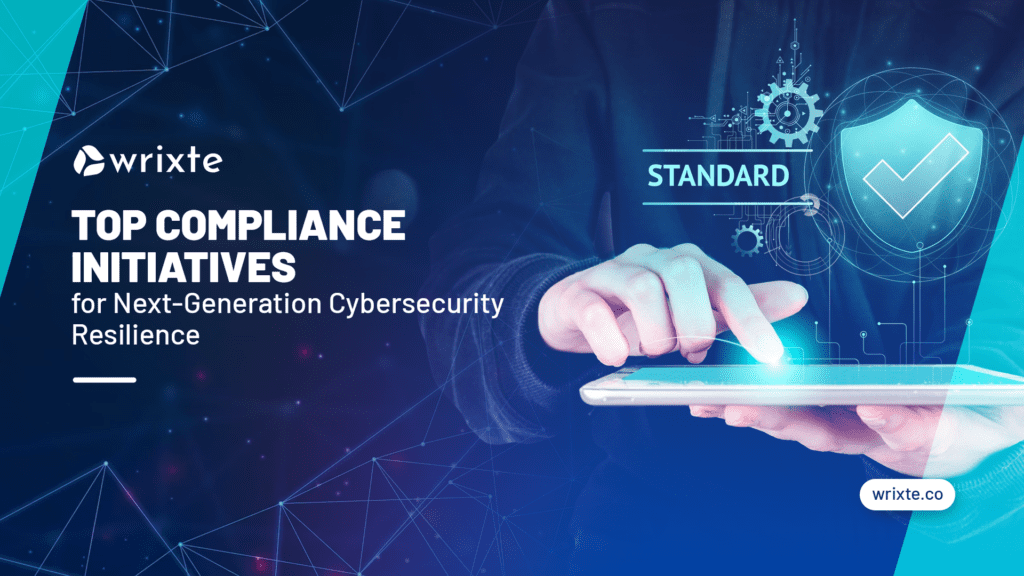The world of cybersecurity is constantly evolving. And maintaining robust resilience against emerging threats demands a multi-faceted approach. As cyber adversaries employ increasingly sophisticated tactics, it is paramount for organizations to align with cutting-edge compliance initiatives. Wrixte aims to provide insights into these top compliance initiatives designed to fortify next-generation cybersecurity resilience.
Zero Trust Architecture (ZTA)
Zero Trust Architecture (ZTA) is not merely a buzzword; it is a paradigm shift that redefines network security. Rooted in the principle of “never trust, always verify,” ZTA assumes that threats can emanate from within and outside the network perimeter. The core components of ZTA involve:
Microsegmentation: Breaking down network segments into micro-perimeters to limit lateral movement by attackers.
Least Privilege Access: Implementing strict access controls, ensuring users have only the permissions necessary for their roles.
Continuous Monitoring and Verification: Employing advanced analytics and AI-driven systems to monitor user behavior and network activity in real-time, ensuring any anomaly is swiftly addressed.
Implementation Challenges
Deploying ZTA involves significant architectural overhauls and meticulous policy configurations. Integrating ZTA with legacy systems requires a comprehensive strategy that balances security and operational efficiency. Furthermore, establishing an identity-centric security model mandates the deployment of robust Identity and Access Management (IAM) solutions.
Advanced Threat Intelligence (ATI)
Next-generation cybersecurity resilience hinges on the proactive identification of threats through Advanced Threat Intelligence (ATI). This initiative encompasses:
Threat Hunting: Leveraging AI and machine learning to proactively search for indicators of compromise (IoCs) and advanced persistent threats (APTs).
Threat Intelligence Platforms (TIPs): Centralizing and analyzing data from various threat feeds to gain actionable insights.
Collaboration and Information Sharing: Engaging in threat intelligence sharing consortiums such as ISACs (Information Sharing and Analysis Centers) to disseminate threat information across sectors.
Deep Dive into ATI Techniques
Behavioral Analytics: Utilizing user and entity behavior analytics (UEBA) to detect anomalies that deviate from established baselines.
Threat Intelligence Automation: Automating the collection, analysis, and dissemination of threat intelligence to reduce the response time and improve threat detection accuracy.
Compliance with Industry Frameworks and Regulations
Adhering to industry frameworks and regulations is crucial for achieving cybersecurity resilience. Key frameworks and regulations include:
NIST Cybersecurity Framework (CSF): Providing a comprehensive guide to managing and reducing cybersecurity risk.
ISO/IEC 27001: Establishing a systematic approach to managing sensitive company information.
GDPR and CCPA: Ensuring data privacy and protection, crucial for maintaining consumer trust and avoiding hefty penalties.
Practical Implementation
Implementing these frameworks involves:
Risk Assessments and Audits: Conducting regular risk assessments to identify vulnerabilities and compliance gaps.
Policy Development and Enforcement: Creating detailed security policies aligned with regulatory requirements and ensuring strict adherence.
Continuous Improvement: Adopting a proactive stance toward compliance, regularly updating policies to reflect evolving threats and regulatory changes.
Endpoint Detection and Response (EDR)
Endpoint Detection and Response (EDR) solutions are critical for monitoring and securing endpoints, which are often the weakest link in an organization’s security posture. EDR initiatives focus on:
Real-Time Endpoint Monitoring: Utilizing advanced analytics to continuously monitor endpoint activities and detect suspicious behavior.
Automated Response and Remediation: Implementing automated responses to isolate compromised endpoints and remediate threats without manual intervention.
Threat Hunting Capabilities: Enhancing EDR solutions with proactive threat hunting to identify and neutralize threats before they cause significant damage.
Technical Insights
Telemetry Data Analysis: EDR systems collect vast amounts of telemetry data, requiring sophisticated data analytics tools to process and derive actionable insights.
Integration with SIEM Systems: Ensuring EDR solutions are integrated with Security Information and Event Management (SIEM) systems for comprehensive threat visibility and incident response.
Secure DevOps (DevSecOps)
Incorporating security into the DevOps process, known as DevSecOps, ensures that security is an integral part of the software development lifecycle (SDLC). Key aspects of DevSecOps include:
Automated Security Testing: Embedding security testing into CI/CD pipelines to identify vulnerabilities early in the development process.
Infrastructure as Code (IaC): Managing and provisioning infrastructure through code to ensure consistency and security across deployments.
Continuous Compliance Monitoring: Implementing tools to continuously monitor compliance with security policies throughout the development and deployment phases.
Advanced Practices
Static and Dynamic Code Analysis: Utilizing static application security testing (SAST) and dynamic application security testing (DAST) to identify security flaws in code and running applications.
Container Security: Employing tools to secure containerized environments, including image scanning and runtime protection.
Conclusion
As cyber threats become more sophisticated, embracing advanced compliance initiatives is essential for next-generation cybersecurity resilience. Zero Trust Architecture, Advanced Threat Intelligence, adherence to industry frameworks, Endpoint Detection and Response, and Secure DevOps represent the forefront of these initiatives. Implementing these measures requires a deep technical understanding and a proactive stance towards continuous improvement and adaptation to emerging threats. By prioritizing these initiatives, organizations can significantly enhance their cybersecurity posture and resilience against an ever-evolving threat landscape. Wrixte is committed to guiding organizations through these complex compliance aspects to achieve optimal cybersecurity resilience.

